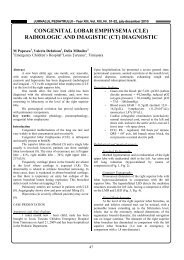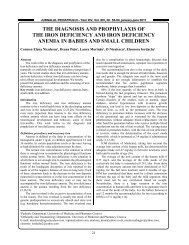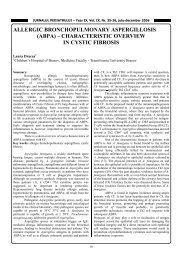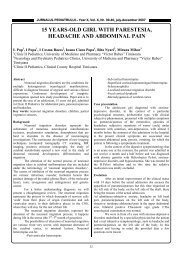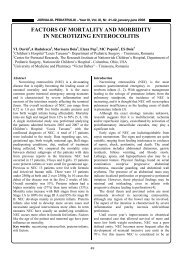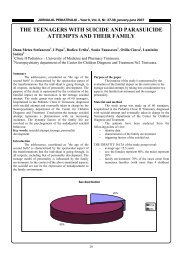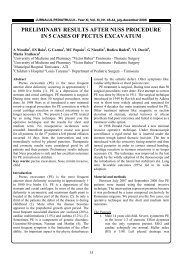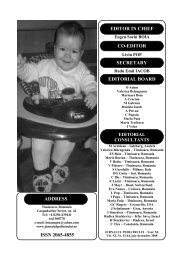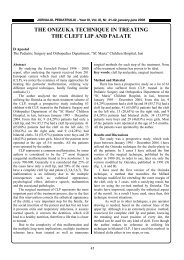address editor in chief co-editors secretary editorial board
address editor in chief co-editors secretary editorial board
address editor in chief co-editors secretary editorial board
You also want an ePaper? Increase the reach of your titles
YUMPU automatically turns print PDFs into web optimized ePapers that Google loves.
JURNALUL PEDIATRULUI – Year XV, X<br />
, Vol. XV, Nr. 59-60<br />
60, , july<br />
j<br />
uly-december 2012<br />
Picture 3: Surgical specimen of cryptorchidism.<br />
Undeveloped testis <strong>in</strong> the place of which a dense capillary<br />
network can be seen <strong>in</strong> a substroma of <strong>co</strong>nnective tissue<br />
(double arrow).Visceral tunica vag<strong>in</strong>alis l<strong>in</strong>ed by<br />
mesothelial cells (th<strong>in</strong> arrows H-E x400).<br />
Picture 4: Surgical specimen of cryptorchidism.<br />
Epididymis (right arrow), vascular <strong>co</strong>nnective tissue<br />
(undeveloped testis) (left arrow) and th<strong>in</strong> stroma of<br />
mesothelial cells that l<strong>in</strong>e visceral tunica vag<strong>in</strong>alis. (th<strong>in</strong><br />
arrows H-E x400).<br />
Discussion<br />
With only 100 cases reported <strong>in</strong> the literature,<br />
polyorchidism <strong>co</strong>nstitutes a rare <strong>co</strong>ndition that is thought to<br />
stem from the abnormal division of the genital ridge dur<strong>in</strong>g<br />
fetal development [5]. Generally an <strong>in</strong>cidental f<strong>in</strong>d<strong>in</strong>g at<br />
surgery, its most <strong>co</strong>mmon form is thriorchidism, although<br />
there are some reported cases of as many as five or even six<br />
testes [6] About 75% of supranumerary testes are<br />
<strong>in</strong>trascrotal and patients normally present with an unusual<br />
scrotal mass. Another 20% are found with<strong>in</strong> the <strong>in</strong>gu<strong>in</strong>al<br />
canal while 5% are located <strong>in</strong> the retroperitoneal space [7].<br />
Testicular duplication must be differentiated from transverse<br />
testicular ectopia where both healthy testes migrate from the<br />
<strong>in</strong>gu<strong>in</strong>al canal to the same hemiscrotum [8]. Polyorchidism<br />
is often associated with other anomalies <strong>in</strong>clud<strong>in</strong>g<br />
cryptorchidism (40%), <strong>in</strong>gu<strong>in</strong>al hernia (30%), testicular<br />
torsion (15%), hydrocele (9%) and neoplasia (6%) [4]<br />
without any evidence to date of chromosomal abnormality<br />
[9]. A 66% prevalence is noted for left-sided lesions and<br />
20% for the right while 14% are bilateral [1].<br />
Thirty-seven per cent of numerary testes display<br />
tubular atrophy and lack of spermatogenic potential [1,10].<br />
Ac<strong>co</strong>rd<strong>in</strong>g to the literature, malignancy has been reported <strong>in</strong><br />
4-7% of cases [11]. However, it is difficult to establish its<br />
precise <strong>in</strong>cidence given the rarity of the <strong>co</strong>ndition and<br />
frequent <strong>co</strong>existence of <strong>co</strong>ngenital cryptorchidism [12].<br />
Theories surround<strong>in</strong>g the embryologic orig<strong>in</strong> of<br />
polyorchidism <strong>in</strong>clude the degeneration of mesonephric<br />
<strong>co</strong>mponents and duplication or division of the genital ridge<br />
[13-16]. The most plausible explanation is the transverse<br />
division of the urogenital ridge at 4 th to 6 th week of<br />
pregnancy. The theory related to degeneration of<br />
mesonephric <strong>co</strong>mponents has been rejected on the basis that<br />
this does not appear to <strong>in</strong>fluence the genital ridge nor the<br />
develop<strong>in</strong>g testicle [14,16,17]. Duplication can only ac<strong>co</strong>unt<br />
for some of the anatomic variations whereas division can<br />
justify all anatomic diversities.<br />
In 1988, Leung ma<strong>in</strong>ta<strong>in</strong>ed that transverse division or<br />
duplication of the genital ridge and tubules by peritoneal<br />
bands <strong>co</strong>uld expla<strong>in</strong> all forms of polyorchidism and went on<br />
to describe anatomic variations on the basis of<br />
embryological development. More specifically, type I<br />
supranumerary testis lacks an epididymis, spermatic duct or<br />
<strong>co</strong>ntact with the healthy testis, type II shares a <strong>co</strong>mmon<br />
epididymis and spermatic duct with the healthy testis, type<br />
III has its own epididymis and shares the spermatic duct of<br />
the ipsilateral healthy testis whereas type IV represents the<br />
<strong>co</strong>mplete duplication of testes, epididymis and spermatic<br />
duct. The most <strong>co</strong>mmon presentation is that of type II; types<br />
II and III together ac<strong>co</strong>unt for 90% of cases of<br />
polyorchidism [5].<br />
The management of polyorchidism rema<strong>in</strong>s a subject<br />
of <strong>co</strong>ntroversy, particularly when the supranumerary testis is<br />
viable, asymptomatic and only identified <strong>in</strong>cidentally.<br />
Formerly, the traditional approach was the surgical excision<br />
of the smaller <strong>in</strong> size testicle [18]. However, Bhogal et al,<br />
favour <strong>co</strong>nservative management that entails regular followup<br />
with magnetic resonance imag<strong>in</strong>g, a non-<strong>in</strong>vasive and<br />
sensitive method, provid<strong>in</strong>g that the <strong>co</strong>ndition is not<br />
ac<strong>co</strong>mpanied by other disorders and does not pose a risk for<br />
malignancy [11,14].<br />
Nonetheless, it should be noted that surgical<br />
management enables testis fixation and formation of a s<strong>in</strong>gle<br />
testicular mass, thereby protect<strong>in</strong>g if from possible torsion<br />
and facilitat<strong>in</strong>g biopsy if needed. Furthermore, it enables us<br />
to <strong>co</strong>nfirm the presence of an outflow tract and the potential<br />
for spermatogenesis [10,17]. Malignancy, dysplastic<br />
changes or absence of spermatogenic potential, as shown by<br />
biopsy, are absolute <strong>in</strong>dications for excision [3].<br />
32



